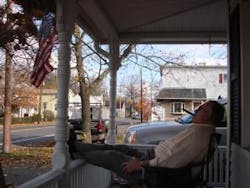Let me pick up where we left off last in my last blog entry. In my community review here in Adelphia I looked at a number of issues. In line with this, a solid plan for the future has allowed us to budget for growth over time. It is better to increase your requests a little bit each year than to be faced with a sudden jump of major proportions. This is particularly critical here in New Jersey where we operate under a four-percent budgetary cap law.
Let us look at how each of these might be addressed in a target community.
1. The population has continually demonstrated potential for growth.
2. The demand for service has increased as the growth has occurred.
3. The changes occurring in my community may have a negative impact upon our ability to recruit new members for the fire department.
4. There has been a decided increase in the number of residential occupancies over the past two decades.
5. Commercial and highway zone development has entered a new growth stage.
6. Our road network does not always allow for ease of apparatus movement throughout the entire fire district. We have a number of smaller, township roads in our response area.
7. Our new residents require the assistance of the fire department to understand the unique safety skills of living in a suburban setting.
8. I observed each of the following transportation and movement mediums during our visits:
a. Roads and highways
b. Aircraft over head (Heavy air traffic from your local airport)
c. The impact of the transport mechanisms must be a part of your planning for future emergency service needs.
9. The potential exists for the development of additional multiple dwelling residential occupancies which occur in response to low-income housing concerns been seen at the state level.
10. It has been my experience that where you have an increase in a given population base that this normally translates in an increased potential demand for service. We have seen this.
11. Most new construction is of a type that is not friendly to firefighters.
12. This creates structural integrity problems, as standards have been diminished to some extent by those construction and materials practices that are allowed by the building code minimum requirements.
13. This problem can be partially attenuated through an increased emphasis on installed alarms, and automatic suppression devices.
14. There are a number of areas which are not protected by fire hydrants. Hopefully this will decrease with an increase in development. Fortunately, a number of water system improvements are under way.
Once the issues like this have been addressed, you must assess what the community will demand of you. You do this by laying out a series of possible events that might occur. Here is an example from a recent consulting job performed by my firm.
After giving each of these criteria a due level of review and concern, I offer the following for your guidance. I believe there are five basic scenarios which exist and that merit additional thought on the part of fire department planners in our community.
· A multiple-dwelling fire
· An industrial/commercial/institutional occupancy fire
· An aircraft crash
· A transportation/haz-mat highway incident
· A large-scale, multiple-casualty emergency medical response on the highways of your township.
Once this is completed, you must assess exactly what your fire department can do with regard to these potential incidents, as well the Target Hazard threats in you area. Target Hazards have been defined as being those occupancies that pose the undue risk of life loss, personal injury, or property damage. Hospitals, nursing homes, hotels, lumberyards, schools, and garden apartment complexes are some of the more common examples of Target Hazard occupancies. A fire department will face large-scale human or property challenges in these sorts of properties.
Just what can your fire department do? Do you have enough people? Are there a sufficient number of apparatus to provide the necessary tools and water? Do sufficient people respond on a regular basis? Are your stations properly positioned to protect your community? Each of these questions must be explored and answered in a satisfactory manner.
If you are short of people, what do you do? How does one get more volunteers? How might you increase your career staff? Only you can answer these questions for your community. The same holds true for every other part of this equation:
People + Apparatus + Water + Tools + Labor = Effective fire protection.
You must not put off until tomorrow what should be done today. The answers to these questions are neither cheap nor easy to solve. They must be answered. You will ignore them at your own peril. Please consider beginning to change the way you think today. Your future will depend on it.
About the Author

Dr. Harry Carter
HARRY R. CARTER, Ph.D., who is a Firehouse contributing editor, is a fire protection consultant based in Adelphia, NJ. He is chairman of the Board of Commissioners in Howell Township Fire District 2 and retired from the Newark, NJ, Fire Department as a battalion commander. Carter has been a member of the Adelphia Fire Company since 1971, serving as chief in 1991. He is a life member and past president of the International Society of Fire Service Instructors and life member of the NFPA. He is the immediate past president of the U.S. branch of the Institution of Fire Engineers (IFE) of Great Britain. Carter holds a Ph.D. in organization and management from Capella University in Minneapolis, MN.
Connect with Harry:
Email: [email protected]
Sign up for our eNewsletters
Get the latest news and updates
